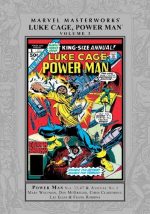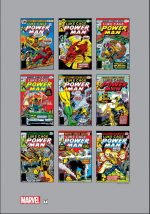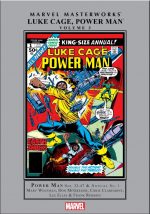


By Marv Wolfman, Don McGregor, Chris Claremont, Bill Mantlo, Ed Hannigan, Roger Slifer, Frank Robbins, Lee Elias, Marie Severin, Ron Wilson, Bob Brown, George Tuska & various (Marvel)
ISBN: 978-1-3029-1635-0 (HB)
As a sickly pale kid growing up in a hugely white area of the Home Counties in the 1960s and 1970s, I got almost all my early experience of black people from television and films (for which I’m most profoundly sorry) – and, of course, comics – for which I’m not.
Blithely unaware of other people’s struggle for equality in my formative years, the incredible consciousness-raising explosion of Black Power after the 1968 Olympic Games rather politicised me, and even though some comics companies had by this time made tentative efforts to address what were national and global socio-political iniquities, issues of race and ethnicity took a long time to filter through to the still-impressionable young minds avidly absorbing knowledge and attitudes via four-colour newsprint pages that couldn’t even approximate the skin tones of African-Americans, Africans, Asians or even white folk with sun-burn or a deep tan.
As with television, breakthroughs were small, incremental and too often reduced to a cold-war of daringly liberal “firsts.†Excluding a few characters in Jungle comic-books of the 1940s and 1950, Marvel clearly led the field with a black member of Sgt. Fury’s Howling Commandos (the historically impossible Gabe Jones who debuted in #1, May 1963, and was accidentally re-coloured Caucasian at the printers – who clearly didn’t realise his ethnicity – for the debut issue), as well as the first negro superheroes Black Panther in Fantastic Four #52 (July 1966), and the Falcon in Captain America #117 (September 1969).
The honour of America’s first black hero to carry his own title came in a little-remembered or regarded title from Dell Comics. Lobo was a gunslinger/vigilante in the old west who sought out injustice just like any cowboy hero would, first appearing in December 1965, and created by artist Tony Tallarico & scripter D.J. Arneson.
Arguably a greater breakthrough was Joe Robertson, City Editor of Marvel’s Daily Bugle, an erudite, brave and magnificently ordinary mortal distinguished by his sterling character, not a costume or skin tone. He first appeared in Amazing Spider-Man # 51 (August 1967), proving in every panel that the world wouldn’t end if black folk and white folk worked and ate together…
This big change slowly grew out of raised social awareness during a terrible time in American history – although Britain had nothing to be smug about either. Following the advent of the “Windrush Generationâ€, race riots in Blighty had started early in the Sixties here (in all honesty, they weren’t a new thing then, either) and left simmering scars that only comedians and openly racist politicians dared to talk about. Shows such Till Death Us Do Part and Love Thy Neighbour made subtly telling headway but still raise a shudder when I see clips today…
Back in the USA, more positive ethnic characters were slowly let in, with DC finally getting a black hero in John Stewart(Green Lantern #87 December 1971/January 1972), although his designation as replacement Green Lantern might be construed as more conciliatory and insulting than revolutionary. The first DC hero with his own title was Black Lightning, who didn’t debut until April 1977, although Jack Kirby had introduced Shilo Norman as Scott Free‘s apprentice (and eventual successor) in Mister Miracle #15 (August (1973).
As usual, it took a bold man and changing economics to really promote change, and with declining comics sales at a time of rising Black Consciousness cash – if not cashing in – was probably the trigger for “the Next Step.â€
Contemporary “Blacksploitation†cinema and novels had fired up commercial interests throughout America and in that atmosphere of outlandish dialogue, appalling apparel and barely concealed – if justified – outrage, an angry black man with a shady past and apparently dubious morals debuted as Luke Cage, Hero for Hire in the summer of 1972. A year later the Black Panther finally got his own series in Jungle Action #5 and Blade: Vampire Hunter debuted in Tomb of Dracula #10.
Cage’s origin was typically bombastic: Lucas, a hard-case inmate at brutal Seagate Prison always claimed to have been framed and his inflexible, uncompromising attitude made mortal enemies of the racist guards Rackham and Quirt whilst not exactly endearing him to the rest of the prison population – such as proudly adamant bad-guys Shades and Comanche…
The premiere issue was written by Archie Goodwin and illustrated by George Tuska & Billy Graham (with some initial assistance from Roy Thomas and John Romita), detailing how a new warden promised to reform the hell-hole into a proper, legal and decently administered penal institution.
Having heard the desperate con’s tale of woe, new prison doctor Noah Burstein convinced Lucas to participate in a radical experiment in exchange for a parole hearing…
Lucas had grown up in Harlem, a tough kid who’d managed to stay honest even when his best friend Willis Stryker had not. They remained friends even though walking different paths – at least until a woman came between them. To be rid of his romantic rival, Stryker planted drugs and had Lucas shipped off to jail. While he was incarcerated, Lucas’ girl Reva – who had never given up on him – was killed when she got in the way of bullets meant for Stryker…
With nothing left to lose, Lucas underwent Burstein’s process – an experiment in cell-regeneration – but Rackham sabotaged it, hoping to kill the con before he could expose the guard’s illegal treatment of convicts. It all went haywire and something incredible happened. Lucas, now incredibly strong and pain-resistant, punched his way out of the lab and the through the prison walls, only to be killed in hail of gunfire. His body plunged over a cliff and was never recovered…
Months later, a vagrant prowling the streets of New York City stumbled into a robbery. Almost casually downing the felon, he accepted a cash reward from the grateful victim, prompting a bright idea…
Super-strong, bullet-proof, street-wise and honest, Lucas would hide in plain sight while planning his revenge on Stryker. Since his only skill was fighting, he became a private paladin – A Hero For Hire…
Whilst making allowances for the colourful, often ludicrous dialogue necessitated by the Comics Code’s sanitising of “street-talking Jive†this was probably the edgiest series of Marvel’s early years (especially under the always evocative and culturally astute Don McGregor) but even so, after a few years the tense action and peripheral interactions with the greater Marvel Universe led to a minor rethink and the title was altered, if not the basic premise…
The private detective motif proved a brilliant stratagem in generating stories for a character perceived as a reluctant champion at best and anti-hero by nature. It allowed Cage to maintain an outsider’s edginess but also meant adventure literally walked through his shabby door every issue.
Cage had set up an office over a movie house on 42nd Street and met a young man who would become his greatest friend: D.W. Griffith – nerd, film freak and plucky white sidekick. Dr. Burstein resurfaced, running a rehab clinic on the dirty, deadly streets around Times Square, aided by beautiful Dr. Claire Temple. Soon, she too was an integral part of Luke’s new life…
This turbulent third hardback (or eBook) compilation collects #32-47 of Luke Cage, Power Man as well as his first Annual – spanning June 1976 through October 1977 – and begins with McGregor’s passionate Introduction ‘Luke Cage and the Big Bad City’ before the inner city, “outasight†action resumes….
Having rebranded himself Luke Cage, Power Man the urban privateer made ends meet whilst seeking a way to stay under police radar and dreamed of clearing his name. A new level of sophistication, social commentary and bizarre villainy began when McGregor took over as writer to craft a run of macabre crime sagas, culminating in saving the entire city from stolen nerve gas…
Issue #32 opens with Cage in the leafy suburbs, hired to protect a black family from literally incendiary racist super-villain Wildfire in ‘The Fire This Time!’ (by McGregor, Frank Robbins & Vince Colletta). This champion of moral outrage is determined to keep his affluent decent neighbourhood white, and even Power Man is ultimately unable to prevent a ghastly atrocity from being perpetrated…
Back in Times Square again, Cage is in the way when a costumed manic comes looking for Noah Burnstein, and learns that ‘Sticks and Stone Will Break Your Bones, But Spears Can Kill You!’ Even as shady reporters, sleazy lawyers and police detective Quentin Chase all circle, looking to uncover the Hero for Hire’s secret past in ‘Death, Taxes and Springtime Vendettas!’ (inked by Frank Springer), Cage’s attention is distracted from Burstein’s stalker by a deranged wrestler dubbed The Mangler, leading to savage showdown and near-fatal outcome in ‘Of Memories, Both Vicious and Haunting!’ (plotted by Marv Wolfman, dialogued by McGregor and illustrated by Marie Severin, Joe Giella & Frank Giacoia) wherein the reasons for the campaign of terror are finally exposed…
Power Man Annual #1 follows as ‘Earthshock!’ – by Chris Claremont, Lee Elias & Dave Hunt – takes Cage to Japan as bodyguard to wealthy Samantha Sheridan. She is being targeted by munitions magnate and tectonics-warping maniac Moses Magnum, who intends tapping the planet’s magma core, even though the very planet is at risk of being destroyed.
Thankfully not even his army of mercenary is enough to stop Cage in full rage…
Next is the cover for Power Man #36 (October 1976). Another casualty of the “Dreaded Deadline Doomâ€, it reprinted LCHFH #12, which featured the debut of the villain who follows in #37’s all-new ‘Chemistro is Back! Deadlier Than Ever!’ by Wolfman, Ron Wilson & A Bradford, as the apparently grudge-bearing recreant attacks Cage at the behest of a new mystery mastermind. He clarifies his position in follow-up ‘…Big Brother Wants You… Dead!’ (Wolfman, Bill Mantlo, Bob Brown & Jim Mooney) as minions Cheshire Cat and Checkpoint Charlie shadow the increasingly-frustrated PI, and repeated inconclusive and inexplicable clashes with Chemistro lead to a bombastic ‘Battle with the Baron!’ (inked by Klaus Janson) who turns out to be a rival mastermind hoping to corner the market on crime in NYC…
The crazed and convoluted clash concludes in ‘Rush Hour to Limbo!’ (Wolfman, Elias & Giacoia) as one final deathtrap for Cage turns into an explosive last hurrah for Big Brother and his crew…
Inked by Tom Palmer, a new vigilante debuts in #41’s ‘Thunderbolt and Goldbug!‘ as a super-swift masked hero makes a name for himself cleaning up low-level scum just as Cage is hired by a courier company to protect a bullion shipment. Sadly, when the van is bombed and the guards die, dazed and furious Cage can’t tell villain from vigilante and takes on the wrong guy…
Answers if not conclusions are forthcoming in ‘Gold! Gold! Who’s Got the Gold?’ (with Alex Niño on inks) as Luke learns who his real friends and foes are, only to be suckered into a deathtrap only barely escaped in #43’s ‘The Death of Luke Cage!’ In the aftermath, with the legal authorities closing in on his fake life, Cage flees town and sheds the Power Man persona, but even in the teeming masses of Chicago can’t escape his past as an old enemy mistakenly assumes he’s been tracked down by the hero he hates most in all the world…
Plotted by Wolfman and scripted by Ed Hannigan with Elias & Palmer on regular artistic duties, ‘Murder is the Man Called Mace!’ sees Luke dragged into the dishonoured soldier’s scheme to seize control of America and despite his best and most violent efforts, beaten and strapped to a cobalt bomb on ‘The Day Chicago Died!’ (Wolfman & Elias).
Sadly, after breaking free of the device, it’s lost in the sewers, prompting a frantic ‘Chicago Trackdown!’ and another savage showdown with Mace and his military madmen in a chilling ‘Countdown to Catastrophe!’ (scripted by Roger Slifer) as a fame-hungry sniper starts shooting citizens whilst the authorities are all searching for the missing nuke…
With atomic armageddon averted at the last moment, this collection – and Cage’s old life – end on a well-conceived final charge. With issue #48, Cage’s life – and his comics title – would be henceforth be shared with mystic martial artist Danny Rand in the superbly enticing odd couple feature Power Man and Iron Fist, but before that there’s still a ‘Hot Time in the Old Town Tonight!’ courtesy of Claremont, George Tuska & Bob Smith as Chicago is attacked by brain-sucking electrical parasite Zzzax! Thankfully, our steel-skinned stalwart is more than a match for the mind-stealing megawatt monstrosity…
With the comics sagas suspended, there’s still treats aplenty here, beginning with a house ad for 1976 Annuals, continuing with Wilson and Joe Sinnott’s art for the ‘Marvel Comics’ Memory Album Calendar 1977′ and ending with a short selection of original art pages by Brown, Mooney & Janson.
Arguably a little dated now (us in the know prefer the term “retroâ€), these tales were nonetheless instrumental in breaking down many social barriers in the complacent, intolerant, WASP-flavoured American comics landscape, and their power – if not their initial impact – remains undiminished to this day. These are tales well worth your time and money.
© 2019 MARVEL.
